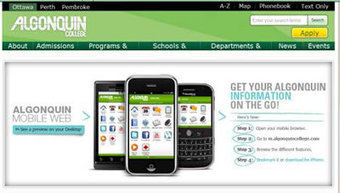 Your new post is loading...
 Your new post is loading...
Social media has become an essential part of most people’s everyday lives, from checking Facebook and Twitter to posting blogs, Pinterest listings, and uploading YouTube videos. However, and with smartphones making it easier than ever to spend time on social media networks, in what ways can these networks be leveraged to engage and build a foundation for future student learning? While the potential of distraction is there, the right social media teaching strategies can lead to creative learning, and a productive approach to making social media part of ongoing professional development. Read more, a MUST: http://gettingsmart.com/cms/blog/2012/11/engaging-students-through-social-media-real-world-experience-creativity-future-employability/
Via Ana Cristina Pratas, Gust MEES, Lynnette Van Dyke
Students who are more self-aware and confident about their learning capacities try harder and persist in the face of challenges (Aronson, 2002). Learn how social and emotional learning can help accomplish this. Choosing the best program to implement social and emotional learning in your school can be daunting. Edutopia's research analyst recommends these research-proven programs.
Project Description This project sought to identify effective strategies that teachers can use within a blended learning environment to enhance learner engagement and achievement. A mixed-method approach was used to collect and analyse data. In total, 541 participants from two North Island universities participated in this project. Ten effective engagement strategies were identified, covering engagement at the beginning of a course, during a course, and re-engaging learners.From the project findings, five conclusions were reached: The quality of learning depends on the depth of student engagement in the learning process.Click on the image to download the summary report (4.67mb PDF)The systematic application of all 10 engagement strategies identified in this study give teachers the best chance of achieving high levels of student engagement.The skills and effort that teachers apply to create learning experiences is the single most important determinant of the quality of the learning environment.Teachers are time-poor and lack adequate technical support and training in pedagogical principles.Blended learning can make a difference. This project was launched at ASCILITE 2012
GEORGE Harrison once said the Beatles saved the world from boredom. But the world has moved on and boredom among students is widespread across university campuses and cyberspace alike. The challenge of apathy is reflected in high attrition rates and low levels of academic engagement. Modern students with short attention spans are held to blame, and short online courses are seen as the latest way to accommodate their caprices. Paradoxically, the rise in attention deficits coincides with an unprecedented expansion in postgraduate study and a lengthening of professional degrees. The rise of student uninterest is matched by a rise of student perseverance. Why do many students lose interest so early, while others now stay in the sector so long? To understand this dilemma we need to isolate the underlying causes and effects of disengagement. The first obvious effect of boredom is that it leads to attrition. In last year's Australasian Survey of the Student Experience, almost one-quarter of domestic students intending to withdraw listed boredom as their primary reason for doing so. More students wanted to leave because of uninterest than because of financial difficulties, health reasons or workload pressures. The last words of these students at university mirror the last words of Winston Churchill: "I'm bored with it all."
Survey of 15,000 Quebec university students shows they’re “old school” when it comes to teaching technology.
Today, most educational systems are designed to work from the microscopic to the macroscopic. Students learn facts and figures and tiny fractions of knowledge long before anyone really puts things into a larger context. We are entering an era of customization. With digitally-delivered education, every student can learn however they want, whenever they want. Or, at least, that’s the promise. The reality is still too one-sided. If you’re a microscopic learner, well the Khan Academy has a bevy of videos for you. So do plenty of other outfits. We’ve got lots of ways to get you knowledge. But if you’re a macroscopic learner? Hmmm. On a certain level, the internet is your general playground. It’s got context all over the place. But what I haven’t yet seen is a specific online macroscopic-to-microscopic learning platform. There’s a huge gap in the market waiting to be exploited.
Fairfax, Va. — Students at George Mason University shifted their feet and chatted outside a classroom here on Tuesday morning, waiting for Stephen Groening’s class on cellphone cultures to begin. On tap was not an ordinary classroom discussion about the assigned readings. Instead, the entire conversation would take place by Twitter, and students were nervous.
JK - A great overview on how to gamify your curriculum. Comes with some useful suggestions on this you need to consider including Badges, Rewards and Levelling Up.

|
Suggested by
Peter Bryant
|
In a face to face environment, the reactions and inter-reactions are measurable and confined to a specific time and space. In online learning they may be spread over days or weeks, with comments or criticisms lying dormant for the entire time, festering directly on the mind of the writer. They may even log in more often to check for responses, getting increasingly frustrated at the flashing annoyance of the VLE proclaiming ‘no new messages’. And perhaps days later when they have moved onto something else, a different concept or interaction, someone picks up the thread and starts it all over again, either responded to or sometimes equally ignored. So, as a practitioner (learner or teacher, or simply interested spectator) what does this mean for the practice of how we manage online learning. Well, I argue there are three critical implications for the design and management of online learning in a disinhibitive environment.
This publication describes a peer mentoring programme that improves the engagement and success of first-year students studying at a distance.
Let's say Professor Smith wanted to use Understoodit. She would start by creating an account and choosing the screen name 'smith'. Professor Smith would then tell her students to go to understoodit.com/smith on their laptop, tablet or smartphone. When students are confused they would click the 'confused' button, and when they understand they'd click 'understood', and in real-time Professor Smith can see the percentage of students that understand. It's that simple. Professor Smith's students only need to create accounts if she wishes to keep track of their progress or answers. This means that Professor Smith can use Understoodit at conference presentations, even if her audience members don't have Understoodit.com accounts.
This paper reports results of a preliminary study on why first–year college students select certain online research resources as their favorite. Results, based on a survey of over 500 U.S. college students in first–year writing classes, offer a more complex picture of student motivation than popular accounts of these students as disinterested, lazy, and ignorant. Students reported most frequently that they favored resources for reasons of ease, quality, and connectivity. They reported least frequently that they favored resources for reasons of relevance, variety, and speed. These results suggest that students value finding scholarly sources above relevant sources.
|
Campbell Walsh was sick of waiting for his NAPLAN test results. ''I wanted to know how I'd done. Using Twitter at schools for students
Organizational change for enhanced student learning and engagement Opportunity Algonquin College in Ottawa has been involved in online learning for over a decade, with courses in distance education, the School of Business, and General Education electives the first to be offered in an online format. From the beginning, the goal of offering more courses online has been to engage students and enhance their learning.
Continuing my research into what motivates highly respected achievers, I’ve come across a few gleaming nuggets of a subject that eludes most of us – what makes some people truly love their jobs. And by “love” I don’t mean that they never have a day when they’d rather be doing anything but their job, but rather that they experience a consistent contentment with what they do.
Geologist Leslie Almberg used a variety of technological options to improve learning in her first year class. Vodcasts, pre-practical lectures and use of the iPad in class all assisted in improving student engagement and learning outcomes.

|
Suggested by
Peter Bryant
|
As always, appreciate the support you have shown on my blog...here is part 2 of the digital stranger blog post
WHEN James Arvanitakis's students go online for one of his lectures, they won't get a dull recording.
Have you ever worried about the level of participation in your online courses? Perhaps you have difficulty encouraging students to interact with one another, or maybe you find student responses to be perfunctory.
We are not totally gamifying our classrooms or currently using Edmodo, so this year I was not really considering the possibility of awarding my students digital badges.
Via Donna Thompson
More and more I am reading articles like this oneColleges worry about always-plugged-in students. In it they talk about college professors and administrators who have or are considering unplugging student’s access to the internet or banning technology altogether so students will focus. These learning institutions are moving in the wrong direction!
When we blame or ban the technology, we solve our issue temporarily, but we are ignoring the root of the problem.
When it comes to learning, many educators know banning is the easy way out, but there are a number of reasons behind why students are not paying attention. Rather than taking away student rights and the freedom to use the tools they want, we must address the root of the issue that is causing the problem. My advice comes from someone who teaches adults and students in a “no ban zone.” These ideas work for me and they will work for you.
Talk about learning in higher education is dominated by buzzwords like "engagement" and "critical thinking." But what really drives student success may be something else.
WGU Texas and three community colleges — Sinclair Community College in Ohio, Broward College in Florida and Texas' own Austin Community College — have received a shared $12 million dollar grant from the U.S. Now that approach, in which students advance after proving their mastery of a concept rather than after a predetermined amount of time in a class, is poised to move from the internet to the physical campuses. “There is nothing magic about online and competency-based,” said Mark Milliron, the chancellor of WGU Texas.
|



 Your new post is loading...
Your new post is loading...

































